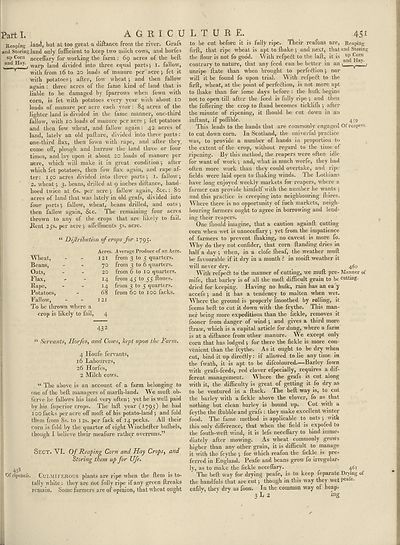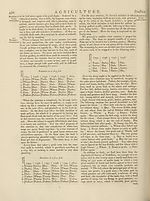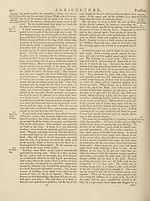Encyclopaedia Britannica, or, a Dictionary of arts, sciences, and miscellaneous literature : enlarged and improved. Illustrated with nearly six hundred engravings > Volume 1, A-AME
(479) Page 451
Download files
Complete book:
Individual page:
Thumbnail gallery: Grid view | List view

Part 1.
AGRICULTURE.
4Si
Reaping land, but at too great a diftance from the river. Grafs
and Storing land only fufficient to keep two milch cows, and horfes
up Corn necefliiry for working the farm : 69 acres of the heft
and Hay. warD jan(j divided into three equal parts ^ I. fallow,
with from 16 to 20 loads of manure per acre 5 fet it
with potatoes 5 after, low wheat *, and then fallow
again : three acres of the fame kind of land that is
liable to be damaged by fparrows when fown with
corn, is fet with potatoes every year with about 10
loads of manure per acre each year: 84 acres of the
lighter land is divided in the fame manner, one-third
fallow, with 10 loads of manure per acre } let potatoes
and then fow wheat, and fallow again: 42 acres of
land, lately an old pafture, divided into three parts :
one-third llax, then fown with rape, and alter they,
come off, plough and harrow the land three or four
times, and lay upon it about 20 loads of manure per
acre, which will make it in great condition ; alter
which fet potatoes, then fow flax again, and rape al¬
ter: 150 acres divided into three parts j 1. fallow j
2. wheat ; 3. beans, drilled at 9 inches dittance, hand-
hoed twice at 6s. per acre ; fallow again, &c.: 80
acres of land that was lately in old grafs, divided into
four parts, fallow, wheat, beans drilled, and oats}
then fallow again, &c. The remaining four acres
thrown to any of the crops that are likely to fail.
Kent 25s. per acre } affelfments 5s. acre.
“ Dijlribution of crops for 1795.
Wheat,
Beans,
Oats,
Flax, -
Rape,
Potatoes,
F allow,
To be thrown where a
crop is likely to fail,
Acres. Average Produce of an Acre.
12i from 3 to 5 quarters*
70 from 3 to 6 quarters.
20 from 6 to 10 quarters.
14 from 45 to 55 Hones.
14 from 3 to 5 quarters.
68 from 60 to 100 lacks.
121
43 2
“ Servants, Hotfes, and Cows, kept upon the 1'arm,
4 Houfe fervants,
16 Labourers,
26 Horfes,
2 Milch cows.
“ The above is an account of a farm belonging to
One of the bell managers of marlh-land* We mull ob-
ferve he fallows his land very often •, yet he is well paid
by his fuperior crops. The lall year (1795) he had
100 lacks per acre off moll of his potato-land ; and fold
them from 8s. to 12s. per fack of 14 pecks. All their
corn is fold by the quarter of eight \\ incheller bufliels,
though I believe their meafure rather overruns.”
Sect. VI. Of Reaping Corn and Hay Crops, and
Storing them up for Ufe.
458 „
Ofripenefe. Culm I FERGUS plants are ripe when the Item is to¬
tally white : they are not fully ripe if any green llreaks
remain. Some farmers are of opinion, that wheat ought
to be cut before it is fully ripe. Their reafons are, Reaping
firll, that ripe wheat is apt to lhake } and next, that and Storing
the flour is not fo good. With refpedt to the lall, it is
contrary to nature, that any feed can be better in an f1 ^ J' 7
unripe Hate than when brought to perfedion; nor
will it be found fo upon trial. With refped to the
firll, wheat, at the point of perfedion, is not more apt
to lliake than for fome days before : the hulk begins
not to open till after the feed is fully ripe •, and then
the fuffering the crop to Hand becomes ticklilli ; after
the minute of ripening, it Ihould be cut down in an
inllant, if polfible. 459
This leads to the hands that are commonly engaged Of reapers,
to cut down corn. In Scotland, the univerlal pradice
was, to provide a number of hands in proportion to
the extent of the crop, without regard to the time ol
ripening. By this method, the reapers were often idle
for want of work; and, what is much worfe, they had
often more work than they could overtake, and ripe
fields were laid open to fhaking winds. 1 lie Lothians
have long enjoyed weekly markets for reapers, where a
farmer can provide himfelf with the number he wants ;
and this pradice is creeping into neighbouring Hires.
Where there is no opportunity of fuch markets, neigh¬
bouring farmers ought to agree in borrowing and lend¬
ing their reapers.
One lliould imagine, that a caution againll cutting
corn when wet is unneceffary ; yet from the impatience
of farmers to prevent lliaking, no caveat is more fo.
Why do they not confider, that corn Handing dries in
half a day ', When, in a clofe flieaf, the weather muff
be favourable if it dry in a month ? in moift weather it
will never dry. > 460
With refped to the manner of cutting, we muff pre- Manner at
mife, that barley is of all the moll difficult grain to be cutting,
dried for keeping. Having no hulk, rain has an ea y
accefs $ and it has a tendency to malten when wet.
Where the ground is properly fmoothed by rolling, it
feems bell to cut it down with the feythe. Ihis man¬
ner being more expeditious than the fickle, removes it
fooner from danger of wind and gives a third more
Hraw, which is a capital article for dung, where a farm
is at a diftance from other manure. We except only
corn that has lodged for there the fickle is more con¬
venient than the feythe. As it ought to be dry when
cut, bind it up diredly: it allowed to lie any time in
the fwath, it is apt to be difcoloured.—Barley fown
with grafs-feeds, red clover eipecially, requires a dif¬
ferent management. Where the grafs is cut along
with it, the difficulty is great of getting it io dry as
to be ventured in a Hack. The bell way is, to cut
the barley with a fickle above the clover, fo as that
nothing but clean barley is bound up. Cut with a
feythe the Hubble and grafs : they make excellent winter
food. The fame method is applicable to oats ; with
this only difference, that when the field is expoied to
the fouth-weft wind, it is lefs neceffary to bind imme¬
diately after mowing. As wheat commonly grows
higher than any other grain, it is difficult to manage
it with the feythe $ for Which reafon the fickle is pre¬
ferred in England. Peafe and beans grow io irregular¬
ly, as to make the fickle neceffary. 461
' The bell way for drying peafe, is to keep feparate Drying of
the handfuls that are cut} though in this way they wet peafe.
eafilv, they drv as foon. In the common way ol heap-
3 L 2 ing
AGRICULTURE.
4Si
Reaping land, but at too great a diftance from the river. Grafs
and Storing land only fufficient to keep two milch cows, and horfes
up Corn necefliiry for working the farm : 69 acres of the heft
and Hay. warD jan(j divided into three equal parts ^ I. fallow,
with from 16 to 20 loads of manure per acre 5 fet it
with potatoes 5 after, low wheat *, and then fallow
again : three acres of the fame kind of land that is
liable to be damaged by fparrows when fown with
corn, is fet with potatoes every year with about 10
loads of manure per acre each year: 84 acres of the
lighter land is divided in the fame manner, one-third
fallow, with 10 loads of manure per acre } let potatoes
and then fow wheat, and fallow again: 42 acres of
land, lately an old pafture, divided into three parts :
one-third llax, then fown with rape, and alter they,
come off, plough and harrow the land three or four
times, and lay upon it about 20 loads of manure per
acre, which will make it in great condition ; alter
which fet potatoes, then fow flax again, and rape al¬
ter: 150 acres divided into three parts j 1. fallow j
2. wheat ; 3. beans, drilled at 9 inches dittance, hand-
hoed twice at 6s. per acre ; fallow again, &c.: 80
acres of land that was lately in old grafs, divided into
four parts, fallow, wheat, beans drilled, and oats}
then fallow again, &c. The remaining four acres
thrown to any of the crops that are likely to fail.
Kent 25s. per acre } affelfments 5s. acre.
“ Dijlribution of crops for 1795.
Wheat,
Beans,
Oats,
Flax, -
Rape,
Potatoes,
F allow,
To be thrown where a
crop is likely to fail,
Acres. Average Produce of an Acre.
12i from 3 to 5 quarters*
70 from 3 to 6 quarters.
20 from 6 to 10 quarters.
14 from 45 to 55 Hones.
14 from 3 to 5 quarters.
68 from 60 to 100 lacks.
121
43 2
“ Servants, Hotfes, and Cows, kept upon the 1'arm,
4 Houfe fervants,
16 Labourers,
26 Horfes,
2 Milch cows.
“ The above is an account of a farm belonging to
One of the bell managers of marlh-land* We mull ob-
ferve he fallows his land very often •, yet he is well paid
by his fuperior crops. The lall year (1795) he had
100 lacks per acre off moll of his potato-land ; and fold
them from 8s. to 12s. per fack of 14 pecks. All their
corn is fold by the quarter of eight \\ incheller bufliels,
though I believe their meafure rather overruns.”
Sect. VI. Of Reaping Corn and Hay Crops, and
Storing them up for Ufe.
458 „
Ofripenefe. Culm I FERGUS plants are ripe when the Item is to¬
tally white : they are not fully ripe if any green llreaks
remain. Some farmers are of opinion, that wheat ought
to be cut before it is fully ripe. Their reafons are, Reaping
firll, that ripe wheat is apt to lhake } and next, that and Storing
the flour is not fo good. With refpedt to the lall, it is
contrary to nature, that any feed can be better in an f1 ^ J' 7
unripe Hate than when brought to perfedion; nor
will it be found fo upon trial. With refped to the
firll, wheat, at the point of perfedion, is not more apt
to lliake than for fome days before : the hulk begins
not to open till after the feed is fully ripe •, and then
the fuffering the crop to Hand becomes ticklilli ; after
the minute of ripening, it Ihould be cut down in an
inllant, if polfible. 459
This leads to the hands that are commonly engaged Of reapers,
to cut down corn. In Scotland, the univerlal pradice
was, to provide a number of hands in proportion to
the extent of the crop, without regard to the time ol
ripening. By this method, the reapers were often idle
for want of work; and, what is much worfe, they had
often more work than they could overtake, and ripe
fields were laid open to fhaking winds. 1 lie Lothians
have long enjoyed weekly markets for reapers, where a
farmer can provide himfelf with the number he wants ;
and this pradice is creeping into neighbouring Hires.
Where there is no opportunity of fuch markets, neigh¬
bouring farmers ought to agree in borrowing and lend¬
ing their reapers.
One lliould imagine, that a caution againll cutting
corn when wet is unneceffary ; yet from the impatience
of farmers to prevent lliaking, no caveat is more fo.
Why do they not confider, that corn Handing dries in
half a day ', When, in a clofe flieaf, the weather muff
be favourable if it dry in a month ? in moift weather it
will never dry. > 460
With refped to the manner of cutting, we muff pre- Manner at
mife, that barley is of all the moll difficult grain to be cutting,
dried for keeping. Having no hulk, rain has an ea y
accefs $ and it has a tendency to malten when wet.
Where the ground is properly fmoothed by rolling, it
feems bell to cut it down with the feythe. Ihis man¬
ner being more expeditious than the fickle, removes it
fooner from danger of wind and gives a third more
Hraw, which is a capital article for dung, where a farm
is at a diftance from other manure. We except only
corn that has lodged for there the fickle is more con¬
venient than the feythe. As it ought to be dry when
cut, bind it up diredly: it allowed to lie any time in
the fwath, it is apt to be difcoloured.—Barley fown
with grafs-feeds, red clover eipecially, requires a dif¬
ferent management. Where the grafs is cut along
with it, the difficulty is great of getting it io dry as
to be ventured in a Hack. The bell way is, to cut
the barley with a fickle above the clover, fo as that
nothing but clean barley is bound up. Cut with a
feythe the Hubble and grafs : they make excellent winter
food. The fame method is applicable to oats ; with
this only difference, that when the field is expoied to
the fouth-weft wind, it is lefs neceffary to bind imme¬
diately after mowing. As wheat commonly grows
higher than any other grain, it is difficult to manage
it with the feythe $ for Which reafon the fickle is pre¬
ferred in England. Peafe and beans grow io irregular¬
ly, as to make the fickle neceffary. 461
' The bell way for drying peafe, is to keep feparate Drying of
the handfuls that are cut} though in this way they wet peafe.
eafilv, they drv as foon. In the common way ol heap-
3 L 2 ing
Set display mode to:
![]() Universal Viewer |
Universal Viewer | ![]() Mirador |
Large image | Transcription
Mirador |
Large image | Transcription
Images and transcriptions on this page, including medium image downloads, may be used under the Creative Commons Attribution 4.0 International Licence unless otherwise stated. ![]()
| Permanent URL | https://digital.nls.uk/193138212 |
|---|
| Attribution and copyright: |
|
|---|
| Description | Ten editions of 'Encyclopaedia Britannica', issued from 1768-1903, in 231 volumes. Originally issued in 100 weekly parts (3 volumes) between 1768 and 1771 by publishers: Colin Macfarquhar and Andrew Bell (Edinburgh); editor: William Smellie: engraver: Andrew Bell. Expanded editions in the 19th century featured more volumes and contributions from leading experts in their fields. Managed and published in Edinburgh up to the 9th edition (25 volumes, from 1875-1889); the 10th edition (1902-1903) re-issued the 9th edition, with 11 supplementary volumes. |
|---|---|
| Additional NLS resources: |
|

